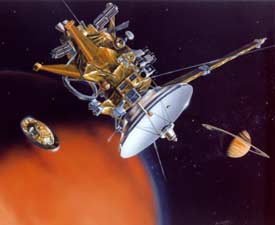
The Cassini spacecraft will reach Saturn in July 2004 and should send the small Huygens probe into the hazy atmosphere of Titan in January 2005. On its way there, Cassini flew nearly behind the Sun from Earth's point of view last year, offering a chance for a highly precise test of general relativity.
Courtesy NASA/JPL.
Albert Einstein still rules. His 1915 theory of gravity, the general theory of relativity, has just passed its most stringent test by far. Extremely precise measurements of the radio link between Earth and NASA’s Cassini spacecraft, bound for Saturn, match general relativity's predictions extraordinarily closely.
However, physicists suspect that even more refined experiments, planned for the near future, could turn up the first deviations — pointing the way to a new and more complete theory of the basic forces of nature and the fundamental makeup of spacetime.
The Cassini experiment was carried out in June 2002, when the spacecraft passed just 9 arcminutes from the Sun’s southern rim (a third of the Sun's apparent diameter) as seen from Earth. Using NASA’s Deep Space Network, Italian astrophysicist Bruno Bertotti (University of Pavia) and his colleagues sent radio carrier waves to Cassini for a couple of weeks and precisely measured the minute frequency shifts in the returned signal.
Due to the warping of spacetime by the Sun’s gravitational field, the round trip time to the spacecraft was a trace longer than it would have been without this relativistic curvature. The result: a tiny extra frequency shift in Cassini’s radio signals.
Like previous testers of relativity, Bertotti and his team expressed their result in terms of a quantity called gamma, which Einstein predicted is exactly equal to 1. (In classical Newtonian physics it's zero.) The team found that gamma indeed equals 1 to a precision of about one part in 40,000. This result is roughly 40 times more precise than the best previous determinations, made two decades ago. "No violations of general relativity have been detected," the group writes in the September 25th Nature.
According to Clifford M. Will (Washington University in St. Louis), a leading relativity expert, the improved accuracy is mainly due to the use of several different high-frequency signals, allowing the experimenters to fully correct for the frequency drifts produced by the plasma of the solar corona. Corrections for the Earth's atmosphere also had to be applied.
"It’s exciting that we’re now starting to probe the regime where deviations from general relativity might play a role," says Will. In their quest for a theory of everything, physicists are toying with extra dimensions, varying fundamental constants, and string-like particles. In particular, physicists assume that an unknown "scalar field" drove cosmic inflation during the first 10–32 second of the Big Bang; this field must have quickly decayed, but traces of it may show up as a tiny deviation from general relativity in the structure of spacetime today. "Most people take these issues pretty seriously," says Will, "but no one knows at what level these new ideas will show up in experimental data."
So far Einstein has always been vindicated. But future space probes, such as NASA’s Gravity Probe B (due to be launched December 6th) and the European astrometry mission GAIA (slated for launch in 2010) could finally take physics to the next step beyond.
 0
0
Comments
You must be logged in to post a comment.